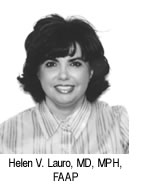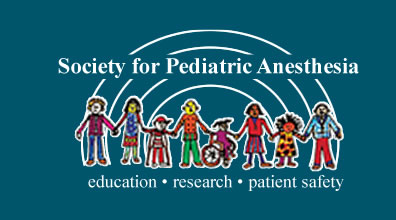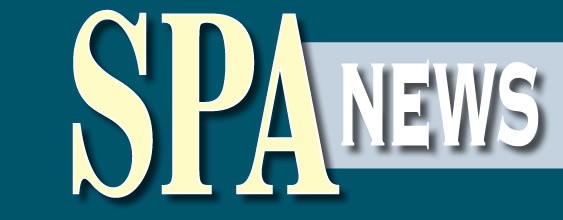![]()
SPA-SPANZA Joint Annual Meeting Review
 By Helen V. Lauro, MD, MPH, FAAP
By Helen V. Lauro, MD, MPH, FAAP
SUNY-Downstate Medical Center
Brooklyn, N.Y.
The Joint Annual meeting of the Society for Pediatric Anesthesia (SPA) with the Society for Paediatric Anaesthesia in New Zealand and Australia (SPANZA) in San Diego, California was the launch of the first combined meeting of the two societies. Stephen Stayer, MD, FAAP (Texas Children’s, Houston, TX) and Andrew Davidson, MBBS, FANZCA (Royal Children’s, Parkville, Australia) provided welcoming remarks.
In the first morning session “Pharmacology—New Drugs and the Future” moderated by Jerrold Lerman, MD, FRCPC (Women’s & Children’s of Buffalo, Buffalo, NY), Anne M. Lynn, MD, FAAP (Seattle Children’s, Seattle, WA) discussed the new drugs in pediatric anesthesia. Antiemetics, neuromuscular blocker (NMB) reversal agents, and sedatives were explored with regard to mechanism of action, indication and dosages, and adverse effects.
Palonosetron, a new “second generation” 5 HT3 antagonist with stronger receptor binding, longer half life, less effect on QT interval was contrasted with ondansetron, the gold standard antiemetic in current use. Aprepitant was introduced as an oral neurokinin 1 (NK1) antagonist that works via substance P system; a related agent, Dr Lynn advised casopitant single is due to be released in late 2010. Sugammadex, a modified gamma cyclodextrin developed for aminosteroid reversal, was contrasted with traditional neuromuscular block reversal agents.
Purported benefits include avoidance of cardiac side effects that require antimuscarinics. While not approved in the US due to adverse events in Phase 1 trials (hypersensitivity symptoms, flushing, rash, bronchospasm), sugammadex is available in Europe, Australia, New Zealand, and Norway. She mentioned a cautionary note that in patients with renal impairment its use should be avoided. Dr. Lynn tackled important issues involving propofol shortages such as formulary differences (soy in European propoven cross reacts in peanut allergy) and sedative alternatives.
Dexmedetomidine (Dex) was proposed as a strong alternative to propofol when administered by loading dose and infusion, due to benefits of reduction in intraoperative rescue fentanyl, reduction in morphine and emergence agitation in recovery room, but this may be offset by cost and longer recovery times. She highlighted the need for prospective randomized blinded studies to be undertaken to clarify the perioperative role of Dex.
Brian Anderson, PhD, FANZCA (Auckland Children’s, Auckland, NZ) spoke on important questions in pediatric pharmacology and how do we get answers. Dr. Anderson pinpointed our goal as achievement of target effect for pediatric medications, and analyzed obvious and more esoteric barriers to target controlled infusions that account for poor effectiveness for children age less than 2 years old, such as differences in EEG, sedation scores, pharmacodynamics, MAC, drug interactions and genetic variability.
Using propofol as a case study, he scrutinized the pediatric pharmacokinetic covariates such as size, age, body composition, pharmacogenetics, drug interactions, where maturation and organ function needs to be factored into traditional clearance formulas together with cost in elucidating volume of distribution and drug clearance in literature. Importantly, he envisions the big challenge in next decade as understanding differences in pharmacodynamics between children and adults.
Joseph R. Tobin, MD, FAAP, FCCM (Wake Forest, Winston-Salem, NC) spoke on the approval process: can I, or should I, use a drug off label? NZ and US perspectives. He presented the quagmire of regulatory issues of the drug approval process as basically similar in three countries (1) New Zealand (Medsafe); (2) Australia (Drug sponsors send applications to Advisory Committee on Prescription Medicine who make recommendations to Therapeutic Goods Administration (TGA)); (3) United States (Food & Drug Administration).
He updated information on the stages of clinical trials—preclinical phase now precedes phase 1-4 and mandates two species animal studies (rat studies are no longer allowed). Phase 4 postmarketing trials, Dr. Tobin reinforced, are especially important for anesthesiologists to be involved with (i.e. “I noticed this and I don’t know if important”). Off-label drug use in children (different doses, routes, ages, disease, and physiological effects) was contextualized as a daily part of every anesthesiologist’s practice (Dr. Tobin’s method to calculate rough pediatric dose is adult dose (kg) divided by 50 kg) and is legal, ethical and not associated with increases in liability. Multi-institutional trials that support pediatric labeling were deemed the only solution for the intractable problem (Gordian knot) of pediatric therapeutic orphans.
The second morning session “Sedation” moderated by Laura Torres, MD, FAAP (Texas Children’s, Houston, TX), and Ian McKenzie, MBBS, FANZCA (Royal Children’s, Parkville, Australia) lectured on An Anesthesiology Lead Sedation Service. For an Anesthesiology Lead service to be effective in the desired primary outcome of reduction in “distress” of the child during the entire hospital stay, patients, income stream, responsibilities, training and sedation must be considered.
The “Comfort Kids Initiative” at Royal Children’s Hospital was launched to maximize postprocedure management in all staff and families. Their model —oral midazolam by protocol by nursing, nitrous oxide by specialized technicians, psychiatry technicians, facilities and equipment, distraction boxes, and finally safe sedation with resuscitation equipment operates seamlessly via education guidelines and protocols, and has been successful orienting clinical leaders, families and patients, and reducing the need of forced restraint for procedures from 18% to 3%.
Joseph P. Cravero, MD, FAAP (Dartmouth Hitchcock, Lebanon, NH) spoke on "Should Anesthesiologists Be Providing Sedation." Against the backdrop of healthcare reform in the United States, Dr. Cravero discussed the future of the specialty and projected growth in number and complexity of sedation or off site anesthesia cases. Using data from the Pediatric Sedation Research Consortium (a collaborative group of 37 institutions dedicated to improving sedation and anesthetic care for children internationally), Dr. Cravero illustrated that propofol sedation and anesthesia by pediatric specialists in highly motivated and organized sedation services has been found to be a safe practice.
In particular, among 131,000 pediatric procedural sedation cases performed by pediatric specialists during 2004-7, the odds ratio of serious adverse outcomes all crossed one. The METI Simulator identified a delay of 5 min period of hypoxia bradycardia by pediatric subspecialists before resuscitation compared to 2 minutes for anesthesiologists in three different sedation environments.
Amid the various sedation service options of traditional OR anesthesiologist, registered nurse sedation with physician oversight, or pediatric specialist sedation with anesthesiologist oversight, a middle road was proposed where anesthesiologists provide sedation when possible to maintain presence in their practice area, yet strive to exert a positive influence on the field, assure appropriate referrals, and provide assistance in formulation of high performance sedation services by other physicians.
Afternoon Session
By Connie Monitto, MD, FAAP
Johns Hopkins Hospital
The afternoon session focused on Safety and Outcomes and was moderated by Jayant K. Deshpande, MD, MPH (Arkansas Children’s Hospital).
The first speaker was Anna M. Varughese, M.D., MPH (Cincinnati Childrens Hospital), who spoke on “How to Measure/Benchmark Safety and Outcomes.” The goals of Dr. Varughese’s talk were to outline a framework of outcome measurement, and review benchmarking, using her institution, Cincinnati Children’s Hospital, as an illustrative model.
Dr. Varughese began by explaining that the Institute of Medicine defines quality of care as the degree to which health services increase the likelihood of a desired health outcome. Initiatives at her institution to improve quality focus on six aims: changes should be safe, effective, patient- centered, timely, efficient and equitable. Specific markers are identified to be used as surrogate measures as these aims are tracked.
Dr. Varughese then focused on factors that must be considered in developing effective measurement techniques. She emphasized that variation in measurement should be considered in this process as it will impact results. In addition, she noted that overcoming measurement challenges requires both a desire on the part of all staff to improve care as well as a commitment by the hospital to invest in the information technology necessary to collect data.
Finally, she defined benchmarking is a continuous process of measuring outcomes, services and practices against your toughest competitor. Different types of benchmarking exist (e.g., internal versus external, competitive versus cooperative versus collaborative). However, the decision as to which style to use requires a decision regarding which aims and measurements are most important.
The second speaker was Donald C. Tyler, MD (Children’s Hospital of Philadelphia), Chair of the SPA Quality and Safety Committee. Dr. Tyler spoke about the “Wake Up Safe” initiative. “Wake Up Safe” is a registry of serious adverse events (SAE’s) in pediatric anesthesia. It is a SPA-based initiative designed to identify adverse and analyze these events, and to provide recommendations for change to improve care.
Initial goals of the project were to decide upon meaningful outcomes and processes that could be measured and tracked. Presently the group is collecting demographic data from between 10 and 12 participating hospitals. Once an event is identified, a mini root cause analysis is performed. The committee has found that impediments to data collection have included both a lack of funding and the fear held by potential participating institutions concerning the risk of litigation. To address this problem the audience was informed that “Wake Up Safe” is now a patient safety organization and, as such, it is protected by federal law from discovery.
In April 2009 data collection went live with paper reporting, and in April 2010 data collection went electronic. Early reports have identified problems involving airway management, as well as wrong-sided procedures – both surgical and anesthetic blocks. Lapses in protocol have occurred in some of these SAE’s. At present, data generated by the project will be disseminated by newsletter. Future goals include enrolling more institutions and identifying more clinically relevant measures to be tracked.
The focus of the next two speakers was to present comparative data from different institutions in Australia and the USA concerning the frequency and outcome from stat calls in the perioperative period. Nick Martin, MB BCh,(Royal Children’s Hospital) discussed an audit conducted at the Royal Children’s Hospital, Parkville, Australia, looking at the use of their stat call system.
Because they were planning the construction of a new hospital, they were interested in determining the best way to summon critical personnel at times of emergency. Their original method involved a buzzer system in the operating room area, but they questioned whether this was the best approach as well as who should respond.
They, therefore, prospectively collected data over a three-year period (2008-2010), and determined that during that time they performed 36,000 anesthetics and had 93 Stat calls for help (approximately 3 per month). They found that 50% of calls were from operating rooms, 32% were from their PACU, and 11% were from induction room. Most calls were made by an experienced anesthesiologist, and over 70% were related to airway issues. Gina Whitney, MD (Vanderbilt Children’s Hospital) then discussed her institution’s audit of PACU stat calls.
They captured data on 91 events over a 12-month interval and found that almost half of all calls were related to airway issues, with ¾ of those due to severe respiratory events. Importantly, 65% occurred within the first 15 minutes of the patient’s arrival to PACU. Early onset problems were often related to the administration of fentanyl by the operating room provider as the patient was arriving to the PACU. Delineation of problems resulted in a number of QI initiatives at their hospital, including having residents present in the PACU, having a code notification system, and implementation of a hand-off tool.
Subsequently, Britta Von Ungern-Sternberg, MB BCh PhD (Princess Margaret Hospital) lectured on respiratory complications in pediatric anesthesia. Respiratory complications are responsible for 1/3 of anesthesia-related cardiac arrests and ¾ of critical incidents. Thus, determining which patients are at greatest risk for problems is clinically important.
Dr. Von Unger-Sternberg described the findings of a prospective cohort study of pediatric patients at her institution, Princess Margaret Hospital, who underwent general anesthesia for surgical and medical procedures. The results of this study, of which she was the lead author, were recently published in the Lancet (September, 2010).
The study’s goal was to identify associations between family history, anesthesia management, and the occurrence of respiratory adverse events. Analyzing data from almost 1000 questionnaires completed over a one-year period, the authors determined that there were a number of risk factors associated with adverse respiratory events (defined here as bronchospasm, laryngospasm, cough, desaturation, and airway obstruction).
Risk factors included a positive respiratory history (nocturnal dry cough, wheezing during exercise, wheezing more than three times in the past 12 months, or a history of present or past eczema), an ongoing or recent respiratory infection, and/or a significant family history of asthma, atopy, or smoking. Interestingly, they found that risk was decreased if the patient had symptoms of an upper respiratory tract infection 2-4 weeks before the procedure, or if the patient underwent intravenous induction compared with inhalational induction, inhalational compared with intravenous maintenance of anesthesia, airway management by a specialist in pediatric anesthesia, and/or use of a face mask as compared to an endotracheal tube for intraoperative airway management. Thus, this study identified factors that could be identified during a preanesthetic assessment to guide decisions in terms of intraoperative anesthetic management.
Finally, Ben van der Griend, MBBS, BMedSc, FANZCA (Royal Children’s Hospital) and Lynn Martin, MD (Seattle Children’s) discussed the results of audits conducted in Australia and the USA regarding anesthesia-related mortality in pediatric patients. Focusing on Australia, Dr. van Der Griend reported that data collection has been ongoing for almost 50 years.
Overall anesthesia-related mortality in Australia is estimated to be approximately 0.19/10,000 anesthetics, but Dr. van der Griend stated that there is only very limited data in pediatrics. However, the Royal Children’s Hospital in Melbourne, a tertiary care pediatric hospital that performs approximately 20,000 anesthetics per year, has performed an internal audit.
The goal of this audit was to track deaths within 30 days of delivery of an anesthetic, and to determine whether anesthesia influenced the timing of death. Looking at over 100,000 anesthetics performed in approximately 56,000 patients they found that their incidence of death within 24 hours of an anesthetic was approximately 13/10,000. The highest incidence was in neonates who had undergone cardiac surgery (194/10,000), while overall cardiac surgery patients accounted for >40% of all deaths.
In addition, they identified 10 cases of anesthetic-related deaths (0.98/10,000), and found that in these cases, severe preexisting medical conditions appeared to be a significant risk factor; specifically 5 of 10 patients identified had underlying pulmonary hypertension.
Dr. Martin then provided a historical perspective of anesthesia-related mortality surveys in the USA. He informed the audience that there have been multiple studies of this topic over the past half century. The first study, published in 1954 by Beecher and Todd, described a retrospective examination of data from 600,000 anesthetics and described an overall mortality rate of 3.7/10,000 anesthetics, with a higher incidence in children <10 years of age (14/10,000).
Subsequently, Rackow, looking specifically at pediatric patients, found that children < 1 year of age were at increased risk of anesthesia-related death. Holzman reported data from The Children’s Hospital, Boston, in which mortality rates were noted to decrease when comparing two time intervals (1.8/10,000 between the years 1954 and 1966 and 0.8/10,000 between the years 1966 and 1978).
In 1993, Morray examined the ASA closed claims database and found further evidence that children appear to have a higher morbidity and mortality than adults, but a limiting factor of this work was the lack of an incidence denominator. This study spurred the development of the perioperative cardiac arrest (POCA) registry which reported its findings in 2000, 2007, and 2010. These reports revealed an evolution in the etiology of pediatric perioperative cardiac arrests.
In the early reports, many were medication-related, while by 2007 less halothane-related arrests were reported, and most recently the risk of cardiac arrest was found to be related to the severity of the child’s underlying disease, the need for emergence surgery, and the presence of congenital heart disease. These results are similar to those recently reported by Flick and Odegard. Both have reported data from their respective institutions (Mayo Clinic and The Children’s Hospital, Boston), which have again suggested an increased incidence of death in the very young and in children with underlying cardiac disease.
Similarly, Seattle Children’s has also performed an audit of 89,000 anesthetics performed between 2005 and 2010 and identified 16 deaths within 48 hours of surgery. Of these three were anesthetic related, and all three involved patients with significant underlying disease. Thus, while separated by thousands of miles, both speakers described similar findings in terms of the incidence of anesthetic-related mortality in children in their home countries.


 Click
Click